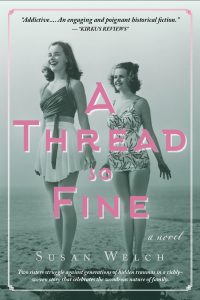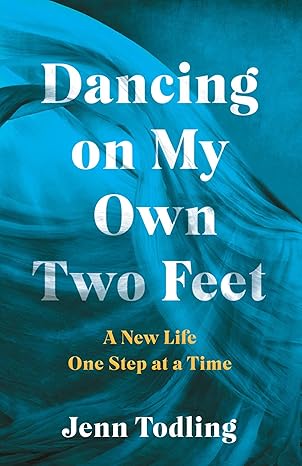Finding Frances and the Serendipity of Characters
 When she finished reading my novel A THREAD SO FINE, a friend asked me how I came to know so much about Frances Perkins, a real-life historical figure who enters the story in chapter ten. It wasn’t my friend’s first question – the novel has more to do with sisters and mothers and long-held, heart- wrenching secrets.
When she finished reading my novel A THREAD SO FINE, a friend asked me how I came to know so much about Frances Perkins, a real-life historical figure who enters the story in chapter ten. It wasn’t my friend’s first question – the novel has more to do with sisters and mothers and long-held, heart- wrenching secrets.
Naturally, we had to get through the basics on Shannon and Eliza, their mother Nell, and young Miriam—their tragedies faced and battles won or lost. But I was equally eager to answer the question about Frances because developing her as a character was among the most rewarding aspects of writing my book. And yet, finding Frances was complete serendipity.
I have no recollection, no dated record or documentation describing when I discovered Frances Perkins, nor how I ‘introduced’ her to Eliza. In the final cut, their first encounter happens in a scene where Eliza attends Mrs. Perkins’ speech on ‘Women and Discrimination in the Modern Workplace’ at University of Minnesota. Given Perkins’ impact on the lives of everyday Americans, I’m embarrassed that I didn’t know about her long ago—in the same way a schoolgirl knows about Harriett Tubman or Eleanor Roosevelt or Cleopatra.
The female household-names of the world’s socio-political history are still too few and far between–a shortcoming of my primary education yet to be fully rectified. Most likely, I found Frances sometime in 2014 when I had finished Part One, but felt lost about the plot and Eliza in particular, for Parts Two and Three.
I cannot for the life of me remember how the venerable Mrs. Perkins made her way into my head and Eliza’s fictitious life, but by now I can say that although a secondary character, her presence is at once essential to Eliza’s arc and to the book’s core theme of what it means to become an empowered woman in the most timeless of ways. For that reason and two others explained below, I can’t imagine my story without Mrs. Frances Perkins.
I am not a classically trained writer (no MFA, at least not yet…); if I were I might better understand the technical function of secondary characters. My intuition is that the most important ones cast the strengths or weaknesses of your protagonist or primary characters into even greater relief—perhaps by possessing those characteristics (positive or negative) in a more pronounced or completed way.
In the example of Eliza, she is smart and increasingly accomplished, yet she can’t help but measure herself by comparison to her friend and mentor, Mrs. Perkins. And at one point in the story when she should be most satisfied, Eliza’s recognition of the greatness of Mrs. Perkins’ moral character and accomplishments edges her toward facing her worst shortcomings—the same emotional blockages that are keeping her from ‘going home.’
Having a historical person such as Frances in my thoughts grounded my creative process in an unexpected and welcomed way. It was as if she and I were the ‘grown ups in the room’ —me, the flesh and blood author and Frances a fully realized, actual character whose life embodied the commonly shared struggles and opportunities in the midcentury America where my story takes place– and in particular for women of that period. She made excellent company and I felt lucky to have her around.
The essence of her being as I understood it became the goalposts through which Eliza had to fit. Frances like Eliza came from privilege and stability but left home at a young age, transplanting herself across the country (to Chicago), and not returning for years. Her adult family life was filled with struggle and sadness but she unapologetically wielded her wisdom and witty intelligence to forge ahead and make a difference in the world that still resonates.
Frances Perkins stood up to the powerful and the bullies to build the very scaffolding of social justice in the U.S. government. Did you know as FDR’s Labor Secretary she was the first female appointed to the U.S. Cabinet and the first female in line to the presidency? Or that she was largely responsible for the adoption of social security, unemployment insurance, federal laws regulating child labor and the federal minimum wage?
Eliza knew nothing of Mrs. Perkins until that fateful day at University of Minnesota’s library– and neither did I when I began my writer’s journey. It makes me wonder if there might be a secret Goddess of Women Writers who is in charge of helping us along.
As I finally wrap my story in its thick and fancy cover and hand it off from writer to reader, I have already begun to anticipate finding characters that serendipity (or that Goddess I’d wondered about…) might throw my way the next time around. Having experienced the joy in discovering an unexpected character—especially a real-life one, I can hardly wait!
—
Susan Welch grew up in Minnesota and Wisconsin with either her nose in a book or her toes in the water. Aside from her day-job doing sales and marketing for a company focused on regional agriculture, new technologies, and craft brewing, she is co-editor of Hot Flash Fiction, a new online literary magazine dedicated to giving voice to stories from, about or of interest to ‘womxn of a certain age.’ Susan lives, works and writes in Seattle and Lummi Island, WA.
A Thread So Fine is her first published novel.
Category: Contemporary Women Writers, How To and Tips




























